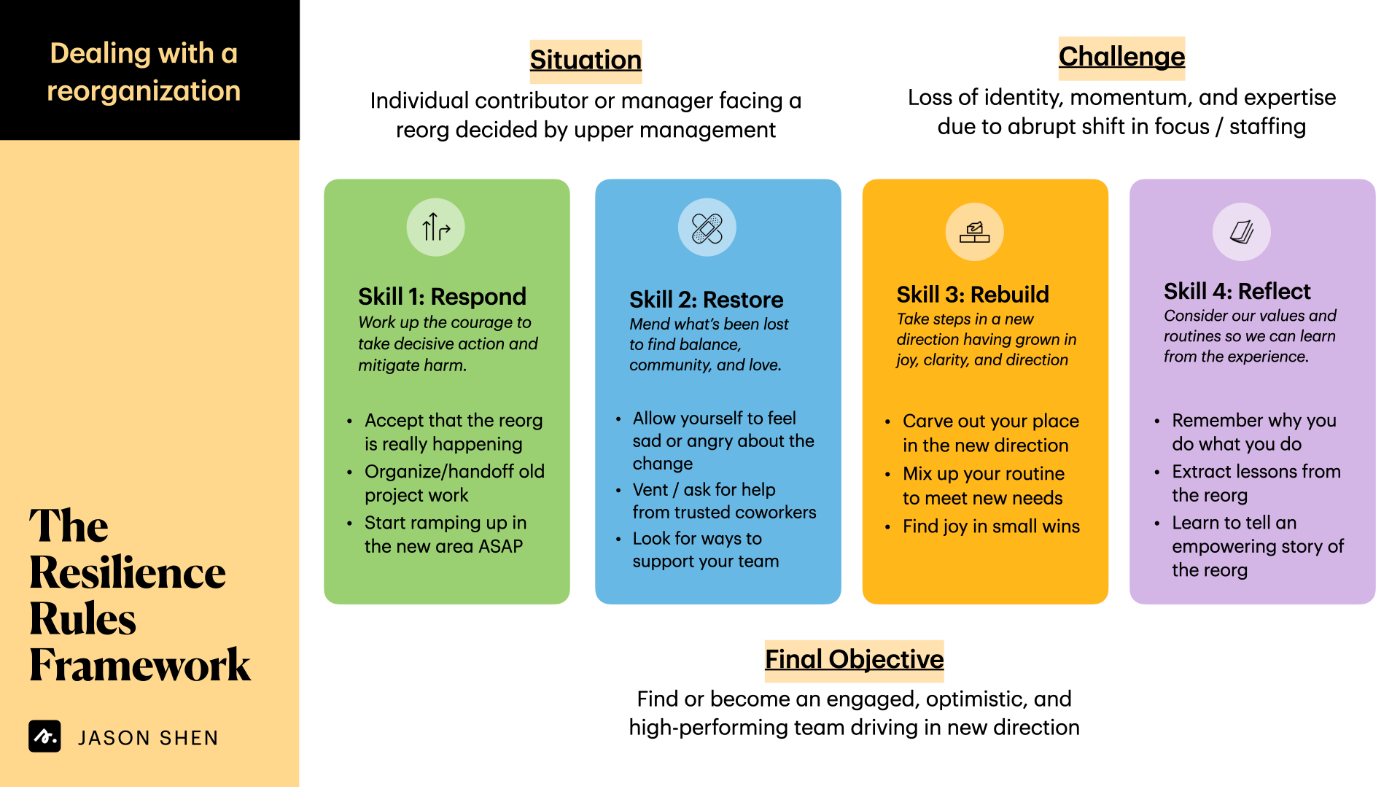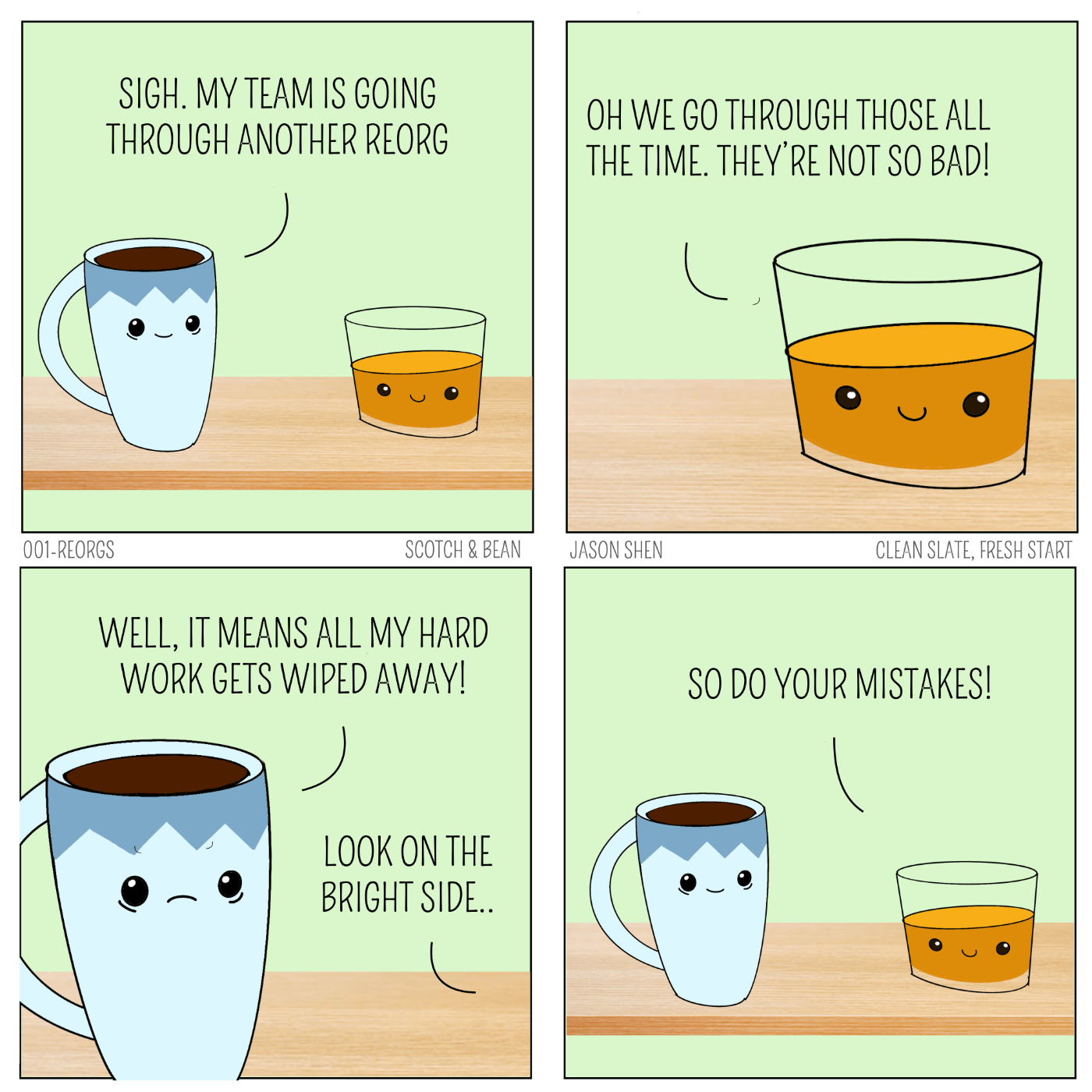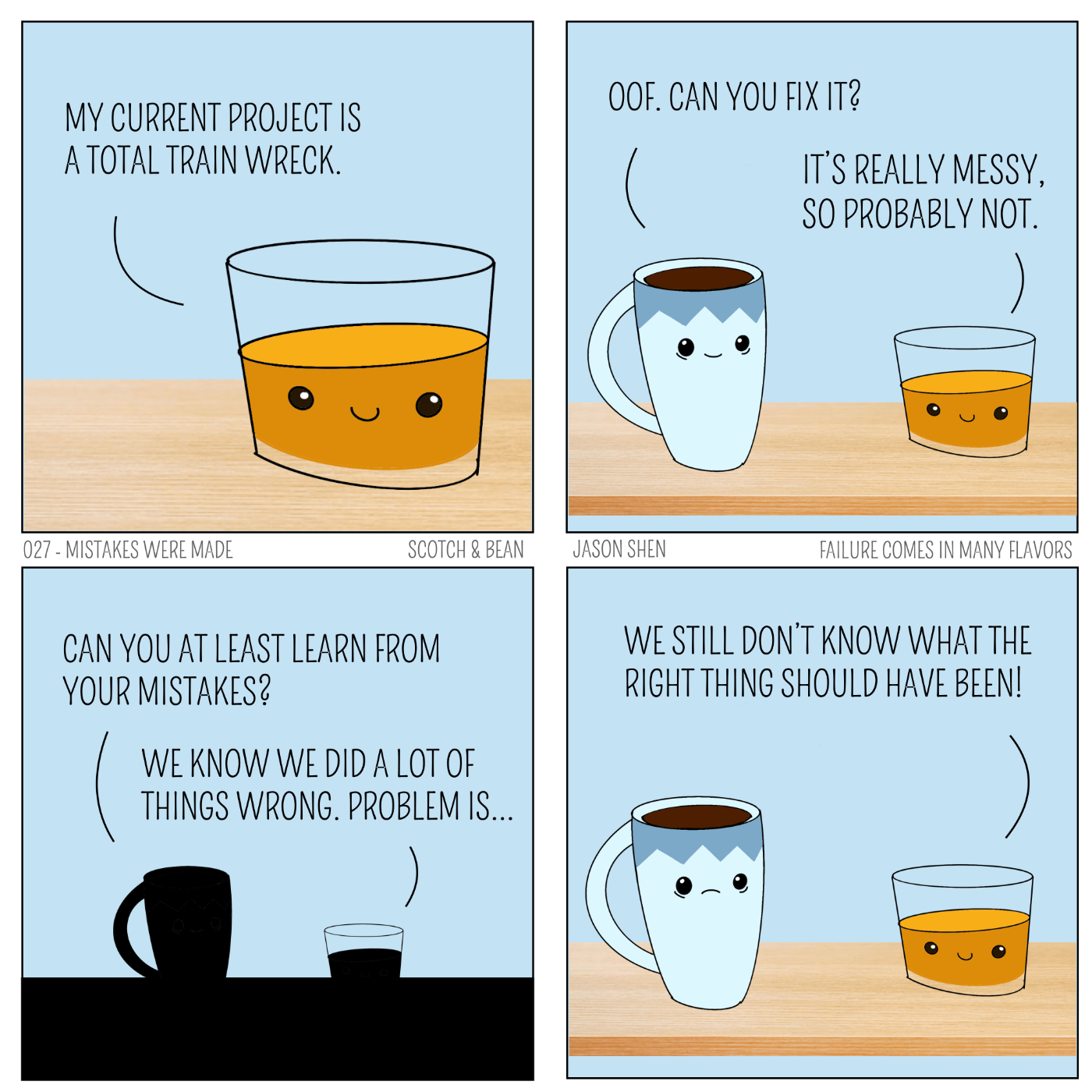
Sponsored By: Flow Club
Today’s newsletter is brought to you by Flow Club, the virtual co-working platform designed for you to feel good about getting work done.
Hello, Every readers! This Friday, Jason Shen is swinging by the Every Discord for a chat about resilience and how you can develop it in your everyday life. If you'd like to join us, you can RSVP here. Now, on to the post!
In late 2019, Andita was hired as a product marketing manager for the London office of a FAANG company. She was stoked. Originally from Singapore, Andita spent years as a management consultant and business analyst. This was her first job as a PMM and her first experience working in big tech. But just two months into her new career, her department went through a major reorg where they lost headcount—Andita’s role was cut. Instead of getting restaffed into one of the remaining teams, Andita had three months to find a new position inside the company or be forced out.
“Reorg” is a five-letter word that can strike fear into the heart of even the most seasoned professional. A reorg—reorganization—is when a group, department, or sometimes an entire company dramatically changes the way they work (e.g. from functional to business unit) or what they work on (booster rockets to landing craft). Reorgs typically involve teams forming or disbanding and individuals taking on new responsibilities and expectations. A reorg might mean you have a new manager, a new office location, a new set of teammates, or all three.
The change and uncertainty brought about by a reorg can send ambitious achievers for a tailspin: was all my hard work for nothing? What does this mean for my career? These are questions without easy answers.
And they are questions more and more workers are grappling with. Given the tumultuous world around us, from pandemics to extreme climate to shifts in consumer behavior and massive upheavals in the supply chain, chances are good that you’re due for a reorg, perhaps with a side helping of layoffs. According to a global 2013 study by McKinsey, 57% of executives had participated in an “organizational redesign” in the last two years with decidedly mixed results.
If you work remote, and feel like you need a little extra motivation and structure to boost your productivity, then look no further than Flow Club. Flow Club is the virtual co-working platform where you can :
- Join a small group that's there to work with you and create accountability through live, video co-working sessions
- Set a goal and skip the awkward small talk
- Use the power of the group to focus on what matters most to you
Slate writer Mia Armstrong tried Flow Club and said, “I accomplished more than I had expected, and I felt a strange sense of connection.”
As a PM at Etsy and Facebook/Meta, I’ve been through numerous reorgs, reshuffles, and rearrangements. And as a three-time founder, I’ve led my own startups through a special type of reorg—the hard pivot—changing not just the roles and responsibilities of my team, but the entire direction of the company.
I’ve seen first-hand how bad reorgs can contribute to layoffs and C-suite departures, and how good ones can create a shared sense of purpose and drive increased revenues. With one of the companies I founded, a reorg even led to a successful acquisition.
In an earlier post, I shared the Resilience Rules I’ve developed over the last few years—you may want to start there if you haven’t read it yet! This post will map those rules to the context of a reorg, so you can see how it all plays out. When you can practice resilience during a reorg, you can transform a frustrating and derailing experience into an empowering one, where you can learn to create more impact and advance your career.
Whether you’re a manager trying to ease the turmoil of a reorg for your team, or a professional hoping to navigate your own ambition as things change all around you, (or perhaps a bit of both), you can use these skills and strategies to cultivate resilience during a reorg. Let’s dive in.
Reorgs | Scotch & Bean by Jason ShenResilience Skill #1: Responding in the Face of Change
In 1995, Bill Gates kicked off a massive reorg via a memo to Microsoft’s executive team where he assigned “the highest level of importance” to the Internet, wanting every product team to “go overboard” on features leveraging the then-nascent technology. ”One element that will be crucial is coordinating our various activities,” Gates wrote, which required teams and departments to radically change how they operated.
Generally, reorgs tend to range from proactive (seeking to take advantage of a new opportunity), to reactive (scrambling to catch up to competitors and changing consumer behavior). Gates’ memo was a bit of both, predicting with great clarity the monumental shift the internet would have on the world, while noting that competitors like Apple and Netscape were already succeeding in the space.
Most people and organizations tend to move too slowly when faced with a significant change or obstacle. We get stuck in denial because change is scary and takes too long to address emerging threats. This is why the first skill of resilience is to respond.
Confront Reality
The sooner you get wind of an impending reorg and accept what it entails, the better off you’ll be. Here are early warning signs of a reorg you can and should look out for:
- More frequent meetings or planning offsites among senior managers.
- Exploratory meetings to discuss “collaboration opportunities” with other teams.
- Getting asked odd questions by your leads around seemingly unrelated projects.
- The announcement of company priorities that seem to strongly diverge from your team’s work
If you’re trying to affect the reorg in any way, this is the time to make your move. By the time you hear a senior leader announce a reorg or talk about a shift in focus, it’s usually a done deal. You might be able to buy yourself some time before a transition but you’re unlikely to cancel the whole thing.
I once spent an exhausting week arguing with Russ, our group engineering manager at Etsy, in a futile attempt to prevent our team from being reorged. That was a week of time that could have been spent making the new project a success, and making things easier on the team members. Andita took a more pragmatic approach than I had, asking her manager and skip-level director if there was anything she could have done differently to prevent her project from being canceled. When they assured her it wasn’t in her control, it made it easier for her to mentally and emotionally move on.
Embrace the Struggle
It never feels good to be forced into something new, especially if you were excited about the previous direction. You might feel like it’s the wrong move for the company to make—and you might be right!—but we don’t have the power to affect everything around us and sometimes we just have to deal with what is handed down.
This rule is about how to make that experience less painful. You might feel sad, confused, frustrated, resentful, lost, or anxious. This is totally normal and to be expected. Rather than fighting or suppressing those emotions, accept that this is what you’re feeling right now.
Focus on constructive coping mechanisms like getting adequate rest, time outside, and journaling, and avoid destructive ones like badmouthing your coworkers, sabotaging your projects, or disengaging all together. Your strong feelings are likely to fade as the transition takes place, so the key is to not make any moves based purely on frustration or confusion. If you’re still feeling awful many months later, it may require a different approach: a larger life change outside of the workplace or guidance from a medical or counseling professional.
When negative feelings lead to a desire to do something you know will be unhelpful, try a technique used in rehabilitation clinics called “urge surfing.” This mindfulness technique starts by focusing our attention on the present, through our breath. After taking a few deep breaths where you try to focus just on the breathing, shift your attention to any urges or cravings that appear, and note where they feel in your body. Visualize those urges like a wave that builds up, crests, and then breaks. By decoupling yourself from your sensations, you can reduce their power and allow you to disengage from the impulsive or immediate response.
Work the Problem
To respond successfully, we have to act decisively despite any sense of ambiguity. Reorgs are a time of heightened activity. Try to wrap up the most important parts of your existing work quickly and start ramping up on your new responsibilities. Ask all the dumb questions, connect with new colleagues, share out relevant memos and past work, and identify the key problems to address in the new area. Put yourself in the shoes of your leadership—the team member who goes out of their way to be project-ready for the next thing will earn their attention and respect.
Alternatively, if you decide you truly want out, the beginning of a reorg is a good time to switch teams or pursue a new opportunity, since things are likely a bit chaotic and your lack of engagement might fly under the radar. But don’t take too long—it’s better to cut the cord early so everyone can adjust. The longer you wait, the easier inertia might lead you to stay.
Above all, work on developing an internal “locus of control” by focusing on you and your team’s efforts in moving forward within the areas laid out by leadership, and not worrying about the stock price or potential deals/projects/launches that are out of your hands. As an elite gymnast, I was taught by our team psychologist that to compete at the highest level, I needed to focus on my training hard each day, getting prepared for a competition, and performing each skill to the best of my ability.
We had a saying: “Every event is its own competition.” It meant compartmentalizing our focus for each of the six events—not ruminating about the previous scores I had received or worrying about anything other than the immediate performance I had ahead. In the same way, you can see this reorg as a fresh start and focus on the task at hand, especially in the most uncertain early days of transition where it will provide reassuring clarity for your teammates.
Resilience Skill #2: Restoring What’s Been Lost
Engineering teams often use the terms P0, P1, P2, P3 to indicate task priorities for a given project. At Meta, the phrase “you are your own P0,” has become a mantra and a shared reminder that caring for your well-being must always be your highest priority ahead of any work task. You can’t stay in firefighting mode forever and reorgs take an unavoidable human toll. Whether you’re a manager or an individual contributor, there are ways you can create space for yourself and your colleagues to restore a sense of safety and connection. Here are some ways you can regain your balance.
Check In
It’s critical during a reorg to stay in touch with ourselves and our teams. In the flurry of activity, we often lose track of how much things may be changing and how the changes have affected us. You might be experiencing a lack of recognition for your previous achievements, your team might feel that their hard work has been wasted. You may feel a loss of confidence as you take on an unfamiliar role with new faces speaking in strange acronyms and jargon you don’t understand.
Labeling our emotions is an effective way to regulate these difficult feelings. In his book on the teenage brain, neuropsychiatrist Daniel Siegel uses the phrase “name it to tame it” to offer parents a way to support and deescalate the powerful and often distressing emotions of their adolescent children.
During my time at the Techstars Alexa program, then managing partner Aviel Ginsburg held a weekly CEO round table where he introduced many of us to the “Traffic Light” check-in. We would begin each session with a quick status on each of our emotional states at the moment, and where it was “trending” or forecasted to be in the near future.
Green meant things were going well: we had lots of energy and optimism. Yellow meant we were experiencing some issues, problems, or negative emotions, but it was mostly under control. Red meant you were in crisis mode, feeling overwhelmed and experiencing significant distress.
While incredibly simple, the Traffic Light check-in at the start of a meeting or 1:1 gives people who might not always be in touch with their emotions (all of us) or who aren’t ready to get extremely vulnerable with a group to at least share their general state. Your color report can then serve as a jump-off point to asking for help or providing support, as we’ll discuss in the next two strategies.
Reach Out
Checking In | Scotch & Bean by Jason ShenAndita understood that a reorg is an important time to connect with others, by building new relationships and deepening the ones you already have. During her two months of standby, when she didn’t know whether she would find another role at the company, Andita reached out to a senior leader she had met once (her skip manager’s skip manager), and asked for advice. Despite her busy schedule, the executive was impressed with Andita’s resourcefulness and ended up meeting several times over the two months to understand Andita’s career aspirations and introduce her to other leaders at the firm.
Successful individuals often struggle to ask for help because they don’t want to be a burden or look weak. But when you help a coworker, you actually tend to like that person more, in part because helping others feels good (this is sometimes called the Ben Franklin Effect). Consider how Wharton Professor, psychologist, and author Adam Grant reframes what it means to ask for help:
If someone you worked well with is moving to a different area because of the reorg, don’t lose touch with them, even if you don’t need help at the moment! Set up monthly or even bimonthly catch-ups. You’ll have someone you can safely vent to, since they’re no longer in your org, and you can swap intel about what’s happening on your respective teams.
Show Care
When we encounter disruptive change, it’s easy to feel angry and resentful: at your leaders, at the universe, even at yourself. Those feelings can be painful and destructive as you try to move forward into this new role.
One way to cultivate self-compassion is to write a letter to yourself from the perspective of a loving friend or family member. Acknowledge the challenges you’ve faced, the courage you’ve shown, and give yourself the support you need to push through this difficult time. If words aren’t your thing, try a different medium like recording a voice memo or creating a drawing that illustrates your feelings (for instance, the cartoons I’ve shared in this and other essays are one way I’m able to express myself).
Once you’ve shown compassion to yourself, work on extending that compassion beyond yourself to others on your team. Research has found that when people focus on supporting others rather than just enhancing themselves they enjoy better mental health and confidence, and are more highly regarded by others. This practice supports some of the ideas we’ll share later in the Rebuild and Reflect sections.
And if you’ve got lingering resentment post-reorg, that’s understandable. Try to remind yourself that most of the people you work with are doing the best they can with what they have—they’re struggling with many of the same challenges you are. And the others? Well, reorgs can bring out the worst in people sometimes and we have to watch out for that.
As for Andita, time was running out. After months of waiting, two open roles were finally posted. Despite already being employed by the company, Andita still had to do full interview loops, totaling 10 separate interviews. And although she had a right to feel frustrated by the ridiculous bureaucracy that led to this re-interview process, Andita made a decision to use this as an opportunity to introduce herself more leaders in the company and build important relationships that could serve her later on. In the end she got what she wanted: a full-time PMM position at a leading tech company (and not having to job hunt during a pandemic).
Resilience Skill #3: Rebuilding for What’s Next
Settling in after a reorg always takes time, and the more people affected, the longer it takes to find a new rhythm. You may have a new team name, but old habits and memories die hard, and dancing to a new tempo takes time and will feature the occasional misstep.
Dream Again
A reorg may mean having to say goodbye: to your previous teammates and projects and find new meaningful goals to pursue. It can be painful to watch a new team foolishly take what was your project in a different direction, or get credit for the success of your hard work—but you have to let all that go and focus on what’s next. This will take time. William Bridges, one of the early authorities on transitions at work, wrote about the “neutral zone” that people must move through between an ending (the past) and a beginning (the future).
Often with a reorg, a new vision or dream has been handed down from up high. But how can you make it your own? If you’re a manager or an individual contributor, you can take time to acknowledge what was good about the past. “Endings occur more easily if people can take a bit of the past with them,” Bridges writes in Managing Transitions. “You are trying to disengage people from it, not stamp it out like an infection. And in particular, you don’t want to make people feel blamed for having been part of it.” What principles, tools, and historical context could be retained even as you move in a new direction?
Andita was pretty shocked during her first reorg and in some ways, the extra time she had to spend waiting allowed her to adjust to the change. Over time, she’s learned to embrace the chaos and reframe how she sees reorgs: “The dream doesn’t die, the legacy just moves on to the next person,” she says. Focusing on how she could successfully hand off her work to a new coworker allowed her to let go of old dreams and set her mind on her new opportunities.
Engage in Ritual
Duke psychologist Dan Ariely writes in the book Payoff about a poorly executed reorg. He noted the team of Seattle engineers he was speaking to seemed particularly forlorn—it turned out the big project they had spent the last two years working on had suddenly been canceled by the CEO and they were all going to be reassigned to new teams.
Ariely notes that the company leaders missed several opportunities to help ease the team through the transition, including having the team do a presentation on what they learned about the experience or asking them to explore how their work could be incorporated into other parts of the business. When you make a big change, it’s worth considering whether there’s some kind of workplace ritual that could help everyone close the book on the past and move into the future.
Because reorgs can shift or interrupt daily routines, you may want to start or modify a regular habit to help you regain equanimity. Do you need to set up a recurring social chat with a work friend? Block out mornings to go for a walk before checking email and Slack messages? Maybe adopt a morning ritual of famous artists for inspiration.
Celebrate Victories
While celebration might be far from your mind, it is actually very important to the long-term success of your reorg and your career. Give yourself reasonable expectations as you ramp up in your new role—don’t come out the gate with some grand vision. Instead, focus on securing short-term wins and take the time to actually savor those successes, however small.
If this sounds a little too entitled to you, consider a 2016 paper entitled “For the Fun of It: Harnessing Immediate Rewards to Increase Persistence in Long-Term Goals”. University of Chicago researchers found that across fitness, healthy eating, and academic related goals, people who chose activities (e.g. workouts, healthy foods) they liked or rewarded themselves immediately after studying with a treat were more likely to stick with their endeavors. In fact, how much they enjoyed those short-term rewards were a stronger predictor of their persistence than their desire for the long-term outcome.
We talked in the last issue about the psychological power of making daily progress in enhancing creative teams. When our future seems uncertain, like after a reorg, those short-term successes become even more important. Look for opportunities to cheer on your teammates and acknowledge even small successes with a celebratory GIF or meme. By securing and saluting small wins, we can coax that kindling dream into a roaring bonfire.
Resilience Skill #4: Reflecting on the Lessons of Change
Reorganizations happen because either the existing system wasn’t working, or because organizational priorities had shifted so dramatically that there was no way to evolve into a new structure, or both. In any of those cases, there is much to learn and adapt as a result of the change.
Make Meaning
When things change, it’s important to connect back to what is most important about our situation. That often means refocusing on the customer or on the organization’s mission and values:
- What is the “why” that drives this work?
- What are the problems we’re trying to solve?
- How should we be working together to solve them?
Often the answers to these questions are more stable during and after a reorg than ones like: Who am I working with? And what are my day to day responsibilities?
One way to stay grounded for yourself is to affirm your personal core values. This requires first identifying behaviors and aspects of life that give your life meaning and that you feel connected to “just because.”. Then you write down what values those behaviors or qualities of life represent—like learning, adventure, intimacy, or hope. Now, write down why this value matters to you, and a time in your life where you really embodied that value. Engaging in this process, known as “affirming one’s values” in the psychology literature, has been shown to reduce stress and anxiety and help develop a positive sense of one’s identity and purpose. Something that’s much needed during a time of transition such as a reorg.
Close the Loop
Even as we ground ourselves in the things that matter, we need to learn and adapt to what the experience has taught us. If the reorg took you by surprise, try to make sure the next one doesn’t. Take steps based on the lessons you learned to ready yourself for future organizational changes. Start organizing key documents and materials as you work on the new project so you won’t have to make them from scratch. Stay abreast of major initiatives across the company so you’re not caught flat-footed next time.
Following her first reorg, Andita learned that change is constant and to better separate her identity from her current project. When she went through later reorgs, she didn’t take the loss of her work personally, but instead saw change as progress and looked at the shift as a new chance to grow. That doesn’t mean she no longer struggles: after a stressful period of work coincided with challenges in her personal life, Andita found herself on the edge of burnout. But her past experiences helped her recognize the danger and she took steps to off-load projects and restore herself before things got worse.
Own Your Story
In order to sell a reorg, senior leaders had to tell a story about how the change would be the right move and how it would unlock a ton of value for the organization. You’ll have to do the same thing for your project and your career. Here’s a template:
- Historically, our team has focused on _____, which allowed us to help the company with _____
- But as we’ve grown and learned more about this space, we’ve realized there’s an emerging opportunity in / a change in customer needs around _____.
- So we decided to shift focus onto ____ as we build towards an exciting vision of ____.
Andita learned to separate her identity from her current project. In only a year, Andita’s new story is being an incredibly resilient go-to expert on change, serving as a company-wide resilience ambassador. These days, she’s the one mentoring others on her team on how to best navigate a new situation, and she gets tapped for exciting new assignments because her leads know she can handle it. She’s turned what would otherwise be a setback—having to reinterview for her job—into a success story.
Every reorg is different and its impact on your work depends a lot on how it’s planned, the size of your company, and the scope of the change. Some of these lessons will be more applicable than others for your situation, especially if the reorg comes after a layoff (which is happening all-too-often in the current economy). What’s more important is understanding that bouncing back after such a major change takes patience as well as proactive measures on your part.
Like with people who really love meetings, you should probably be wary of anyone who’s obsessed with reorgs. But a complex, interconnected economy, succeeding as an organization means evolving with macroeconomic trends, tech advancements, and consumer behavior. Ultimately, reorganizations are just one of the many ways we experience change. By practicing the skills of resilience, we can respond with courage, acumen, and empathy when our world turns upside down.
In our next issue, we’re going to step away from the framework and debunk some of the toxic myths around toughness, self-reliance, and being an alpha. It’s a fun one.
Jason
PS - Have you recently gone through a reorg? What was the biggest lesson you learned?
PPS - I posted this video I made about reorgs into a meme channel at work and it went semi-viral because reorgs are a very common occurrence at Meta. I got DMs from a dozen people in different departments actively going through a reorg when they saw the video. Here it is for your viewing pleasure.
Find Out What
Comes Next in Tech.
Start your free trial.
New ideas to help you build the future—in your inbox, every day. Trusted by over 75,000 readers.
SubscribeAlready have an account? Sign in
What's included?
-
Unlimited access to our daily essays by Dan Shipper, Evan Armstrong, and a roster of the best tech writers on the internet
-
Full access to an archive of hundreds of in-depth articles
-
-
Priority access and subscriber-only discounts to courses, events, and more
-
Ad-free experience
-
Access to our Discord community
Thanks to our Sponsor: Flow Club
Join Flow Club if you want a motivation boost to help you achieve your goals with focused and committed individuals across the internet.






Comments
Don't have an account? Sign up!